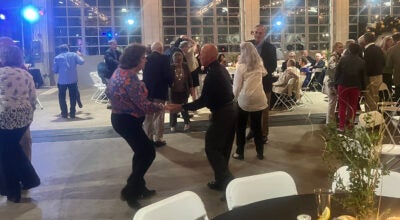Published 12:00 am Friday, April 22, 2011
Renowned wilderness conservationist Dave Foreman delivered a passionate message at the Center for the Environment facility on the Catawba College campus Tuesday evening for humans to help save wild habitants and habitats.
“Earth is in an unprecedented situation …” he told the more than 100 people who turned out for his “Overpopulation, Mass Extinction and Rewilding” presentation. “We’re in the middle of a mass extinction and that mass extinction is caused by one thing — one species — and that’s us.
“It is our overpopulation and overconsumption that is driving the takeover of the whole earth and the endangerment of species from the poles to the equator, from the bottom of the ocean to the heights of the atmosphere.”
Dave Foreman spoke to about 100 people at the Center for the Environment building. At age 64, Foreman said he has seen the earth’s population triple in his lifetime. “We’re at 7 billion today,” he said, “and the United Nations under its moderate growth patterns says by 2050, we’re going to have 9.2 billion.” Other estimates project a population as high as 12 billion by then.
The overconsumption includes overkill. “We take too much out of the oceans,” he said. “The shark population has dropped 90 percent in the last 10 years … That’s just one example.”
Foreman said humans are part of an ecological community with other species. “We need to learn how to be good neighbors and one way to do that is by sharing space on this earth,” he said.
Sponsors for his presentation were Duke University’s Nicholas School of the Environment, Davidson College’s Environmental Studies Program, Warren Wilson College’s Environmental Leadership Center, Elon University’s Center for Environmental Studies, the LandTrust for Central North Carolina and the Center for the Environment.
Despite the dire situation facing the planet, Foreman said he was going to focus on the positive in his talk. “My generation has handed your generation a bad stack of cards,” he told the young people in the audience, “but you can make it better, and I’m going to spend the rest of my life trying to make it better, too.”
Foreman has spent his career as a wilderness conservationist, working for The Wilderness Society during the 1970s as Southwest regional representative in New Mexico and as director of Wilderness Affairs in Washington, D.C. He also served as editor of the Earth First! Journal and executive editor and publisher of Wild Earth.
Foreman was the recipient of the 1996 Paul Petzoldt Award for Excellence in Wilderness Education and in 1998 was named by Audubon Magazine as one of the 100 Champions of Conservation of the 20th Century. The author of several books, including his latest — “Rewilding North America” — he is currently executive director and senior fellow of The Rewilding Institute, a conservation think tank which advances ideas of continental conservation.
Foreman also writes an Internet column called “Around the Campfire.”
In introducing him, Dr. John Wear, Center director, said Foreman is considered one of the nation’s most effective and inspirational speakers on conservation.
For 20-to-30 years now, Foreman said conservationists have been talking about a North American Wildlife Network anchored by four continental wildways. He focused on rewilding the East through a wildway along the Appalachian Trail.
When he talks about the other wildways, Foreman said most people say, “Yeah, I can see that’s possible.” But when he mentions the East Wildway extending from Maine to northern Georgia, “a lot of people don’t see how we can rewild Appalachia.” They say it’s too built up, he said, there’s too many people, it’s too fragmented, there’s not enough public land or wilderness areas, etc. “So there’s all these problems with rewilding the East.”
Earlier Thursday, however, when Foreman was walking with Wear around the 189-acre ecological preserve behind the Center, he said it became clear to him that the East is different from the West because it is so much more resilient. “Things come back faster here,” he said. “I know some clear cuts in northern New Mexico that were cut in the late 1960s, and they still don’t have trees in them.
“But a lot of this was farmland 50, 60, 70 years ago,” he said of the preserve.
Foreman said there’s nothing radical about rewilding the East. The late forester Benton MacKaye, founder of the Appalachian Trail, was thinking about the concept in the 1920s as a “string connecting pearls of wilderness.” He cited similar efforts in the years since then.
“I think the No. 1 thing we need in the East is the cougar,” Foreman said, a project proposed about 25 years ago in a study by the U.S. Fish and Wildlife Service. “They came up with about 20 different spots in the southeastern United States as possible cougar recovery areas, but nothing really came of it.”
Research in Uruguay showed that when the black jaguars began disappearing, the ecosystem began breaking down. A study at the University of Wisconsin found that there are fewer and less diversity of wildflowers when there are no wolves or lions in the area.
Foreman said cougars could blend in well in the eastern United States. “There could be cougars out there,” he said of the preserve, “and nobody would ever know. They might see some tracks on the trails, but that would be it.”
Another problem with rewilding the East is that the land is more fragmented, making acquisition more difficult. Foreman said a key to wilding the East is getting serious about closing some of the numerous dirt roads.
In the West, there are 328 roadless areas of 100,000 acres or more, he said, as compared to only 30 in the East and not many of them are over 50,000 acres.
When asked to pass legislation protecting 35 million of the 61 million acres of roadless areas in the national forests, Foreman said former President Jimmy Carter only protected 15 million. “And he was a friend of us,” he said. “We felt like we got the shaft, and that’s why I started Earth First.” In January of 2001, however, Former President Bill Clinton approved protecting all the roadless areas of the national forests.
Foreman said the key to wilding the East is asking for it. “If you’re shy and you’re embarrassed to say what we really should have like cougars back … you will not get them,” he said. “I can guarantee you that. But if you have the vision and the courage and the love of land and for wildlife, you just might get it, and you will change the world to a much better place than it is …
“I can’t think of any way to be a better neighbor than to show some humility to the magnificence of this glorious creation than to help the East rewild itself.”
It’s important for human beings to step back and not impose our will on everything, Foreman said. “For thousands of years, that’s what we’ve done. We’ve imposed our will on the land, on other living things.
“We have tried to be the conqueror of everything, and it’s time for us to grow up, to have a little respect, a little humility.
Foreman thanked Fred and Alice Stanback for encouraging him to come speak at the Center for the Environment. “We finally got it worked out,” he said, “and I had a great day here tonight.”
He signed books for people in the audience after his presentation at a reception in the Center library.
***
The Center for the Environment at Catawba College was founded in 1996 to provide education and outreach centered on prevalent environmental challenges and to foster community-oriented sustainable solutions that can serve as a model for programs throughout the country.




